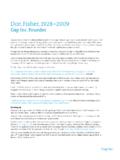Transcription of Refining IFRS Spin outs Feb 2013 final - Ernst & Young
1 February 2013 . spin -off transactions Addressing the key financial reporting challenges Refining ifrs . Mining & Metals The challenges of managing spin -offs What you need to know While there is some specific Mining and metals entities operate in a challenging and ever-changing environment of cost guidance as to how and when inflation, slowing economic growth, heightened geopolitical risk and volatile prices. With to account for spin -off margins squeezed, entities are under continuing pressure to control costs, allocate capital transactions, significant wisely and maximise returns.
2 For entities with sustainable cash flows, strong liquidity and management judgement is still projects close to production, there is strong demand from credit markets that are keen to required. support them through the provision of funding. In light of this, the sector is shifting its priorities to focus more on cost control, credit quality and disciplined growth, to maximise A number of key decisions, and near-term shareholder returns. Entities are therefore seeking to optimise capital through specifically the timing of these ongoing appraisals of their portfolios, including seeking to divest non-core assets, to release decisions, can significantly capital.
3 Impact an entity's balance sheet and its profit or loss and Some entities, particularly advanced juniors and mid-tier mining and metals entities, are potentially other parts of its struggling to realise value for their assets in a competitive, high-risk and often-misunderstood business. sector. In addition, some majors are exploring new ways to recycle capital from high-cost operations. Other entities are assessing how well aligned each asset in their asset portfolio is Understanding the implications with their broader strategic goals. As a result of these and other drivers, some entities across and financial reporting the sector are spinning off individual projects or commodity groups, and/or non-core assets, challenges are an essential part into separate businesses.
4 Of the effective management of a spin -off. The increasing popularity of spin -offs is a reflection of the struggle some entities face in getting the market to understand and fairly value the assets and their future potential. One of the key benefits of a spin -off is the increased visibility it brings to an entity's assets. The increased visibility of assets, when underpinned by a well-articulated and focused strategy for how capital will be invested to deliver growth, inspires investor confidence and enables the business whether a single- or multiple-commodity entity to be benchmarked against a relevant peer group.
5 Such a strategy is central to maintaining investor support and attracting investment. As well as bringing visibility and strategic focus (and therefore value) to the core/key asset(s), spin -offs provide investors with the opportunity for direct exposure to the divested hidden'. assets. In addition to the commercial challenges associated with executing a spin -off, there are some key financial reporting challenges. Despite some existing ifrs guidance, there still appears to be some diversity in practice. We believe this is because significant management judgement is still needed when applying the accounting requirements.
6 In this issue of Refining ifrs , we explore some of these financial reporting challenges and the key areas of judgement. Defining a spin -off assets to be distributed) appear to be the same as those of the entity that will now hold the newly spun-off assets, this is not For the purposes of this publication, we are specifically sufficient on its own. considering those spin -off activities that involve the creation of a new entity, independent of the existing parent entity. The new This is because to be regarded as having control, a contractual entity will house certain assets (or an existing business/division arrangement must exist between all shareholders, or a group of of the parent) that have been transferred or spun off - into the individual shareholders, receiving the distribution that provides new entity by the existing parent entity.
7 In return for spinning them with the ultimate collective power (control) over the off the assets, the parent entity will receive shares in the new financial and operating policies of the entity making the entity. The parent will then distribute these shares to its existing distribution. Therefore, without such a contractual shareholders, for no consideration. arrangement, such transactions would fail to satisfy this requirement. spin -offs may also be referred to as spin - outs or demergers. How we see it Key financial reporting challenges spin -off transactions result in non-cash distributions to the Most spin -offs will fall within the scope of IFRIC 17.
8 This is owners of an entity (these may also be referred to as dividends, because they will meet the specified criteria and will generally but we will use the term distributions' for the purposes of this lack a contractual arrangement between the owners that publication). ifrs has always required the details of these types enables an entity to assert that the non-cash assets are of distributions to be presented either in the statement of ultimately controlled by the same party, or parties, before and changes of equity or in the notes to the financial statements. after the distribution.
9 Nevertheless, ifrs had not originally included guidance on a number of key areas, specifically: How to initially account for a spin -off transaction How to initially account for a spin -off transaction How to account for a spin -off transaction in subsequent The two key challenges in initially accounting for a spin -off are: reporting periods (if applicable) When to recognise a spin -off How to account for a spin -off transaction at transaction How to measure a spin -off settlement What to do with the associated transaction costs When to recognise a spin -off What needs to be disclosed In substance, a decision to spin off assets to an entity's owners In response to the lack of guidance and consequent diversity in represents the intention of the entity to make a non-cash practice, IFRIC 17 Distribution of Non-cash Assets to Owners distribution to its owners.
10 Similar to the payment of a cash (the interpretation) was issued. dividend, a liability must be recognised in relation to the spin -off We examine in more detail below how the interpretation now transaction at the point that the entity is obliged to make the addresses each of these areas and we highlight some of the distribution to its owners. Such an obligation arises only once related challenges. We also discuss which types of transactions the spin -off decision is appropriately authorised and is no longer are likely to fall in scope of the interpretation. at the entity's discretion.















